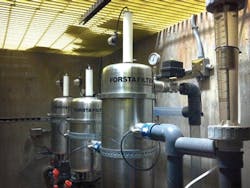Filters: Springwater Filtration
About the author: Polly Stenberg is director of sales for Forsta Filters Inc. Stenberg can be reached at [email protected].
According to the U.S. Environmental Protection Agency (EPA), more than 94% of the nation’s 156,000 public water systems serve fewer than 3,300 persons. These systems—classified as “small” by EPA—face unique financial and operational challenges in providing drinking water that meets EPA standards.
In the small community of Encinal Village, N.M., a spring-fed water system is the sole source of drinking water. The system is classified by EPA as Schedule 4, and serves approximately 200 people and 60 homes.
The system is run by the Laguna Pueblo Utility Authority, and operates in compliance with EPA’s LT2 Enhanced Surface Water Treatment Rule, which provides guidelines for source water monitoring and filtration.
Raw water from the springs near Encinal Village had low turbidity (0.05 ntu), but there was concern that strands of grass and other plant material would shorten the service life of the 1- and 5-μ cartridge filters selected for LT2 compliance.
Solution for Debris
David Steen, P.E., senior field engineer for the Indian Health Service, wanted to reduce the labor and replacement costs of disposable filters. Steen provided Forsta engineers with a raw water sample from the springs. The sample included fibers and other debris that were negatively affecting the fine cartridges. Results of sample testing would inform the screen selection for a new automatic, self-cleaning filter system to serve as prefiltration to the finer polishing cartridges.
To assess the debris present in the raw spring water, engineers conducted tests using a descending sequence of screen mesh sizes. The test showed the concentration of debris at select sizes, and also indicated the finest screen appropriate for the Encinal spring water source.
Based on the test results, Steen selected a three-stage filtration sequence with 25-, 100- and 1,000-μ screens. The fully automated three-stage plan would provide reliable prefiltration, extend the service life of the LT2 compliance filters and reduce maintenance requirements.
The system went online in the summer of 2011. Operating conditions in the field were monitored over the course of several months. Based on an initial review of the flush frequency of each of the filters it was determined that reducing the 100-μ screen to a 50-μ alternative would help to balance the system.
Engineer Eran Fischer provided an onsite training and installation evaluation to coincide with the screen changeout. The simple screen adjustment effectively reduced the workload on the final 25-μ filter and streamlined the operation of the system as a whole.
During the installation review, Fischer confirmed that each of the filters had sufficient inlet pressure during backwash (minimum 40 psi) and minimal back pressure on the flush line, and that differential pressure on each of the filters returned to less than 1 psi after each cleaning cycle was complete.
Flow from the springs remains at a fairly consistent 85 to 100 gal per minute and the system operates 24/7. The 1,000-μ filter currently is set to backwash once per day on a timer. The 50-μ filter backwashes twice per day based on pressure differential, and the 25-μ filter backwashes once per hour based on pressure differential. Per 24-hour period, the cleaning cycles of the complete filtration system use approximately 216 gal, with no interruption to system flow during the backwash sequence. Backwash water goes to a drain, which feeds into a ditch collection and the irrigation system in the village.
Still Successful
Certified Water and Wastewater Operator Andrew Sweetman has operated the filters for Laguna Pueblo for more than three years and is also the facility quality assurance/quality control manager. When asked about the system, he said, “Working with the Forsta equipment has been relatively easy and hassle-free. At our installation, the filters are readily accessible, compact, easy to isolate for maintenance and easily disassembled for periodic maintenance.”
Sweetman said that he would highlight the automatic backwash and self-cleaning operation of the filters, their use with high pressure flows and the robust nature of the steel screens and filters as benefits of the equipment.
In order to examine the particle removal efficiency of the system at four years in operation, Sweetman collected 1-gal samples prior to the 1,000-μ filter (raw spring water) and after the 25-μ filter.
Total suspended solids were reduced across the three-stage system from 0.33 to 0.04 ppm, for an overall reduction of 88%.
Particle size analysis showed that 100% of particles were removed above the absolute degree of filtration (34 to 36 μ) of the finest screen (25 μ).
The analysis also showed a 63% particle reduction in the 1- to 36-μ size range, with particle loading reduced from 0.08 to 0.03 ppm. Particle removal in this range is due to what has been referred to as “the filter cake effect,” which describes the phenomenon of screen orifices becoming smaller as a screen accumulates dirt.
With increasing drought conditions in the western U.S., efficiency and water conservation are important considerations for many municipal water systems. According to Steen, the output of the springs on this specific system has not decreased. Laguna has, however, seen some decline in other wells.
In addition to using water-efficient technologies in its centralized treatment plant, Steen explained that Laguna has started to monitor individual meters and contact homes with suspected leaks. The reliable and efficient four-year operation of Laguna’s three-stage self-cleaning filtration system has saved the water authority an estimated two to four cartridge filter replacements per year. This has amounted to reduced costs in equipment and labor.
Download: Here
